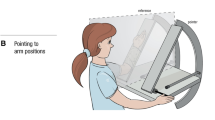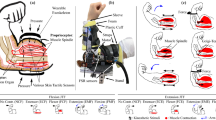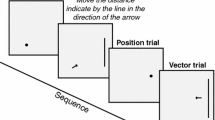Summary
An experiment is reported which examined whether gravitational torque acting about a joint is used by the CNS in elbow joint angle matching. Subjects were required to match the joint angles of their two limbs while the external torques acting about each elbow were systematically varied. It was found that when the matching limb was differentially loaded, the error in the produced reference angle corresponded to the directional prediction of a proposed gravitational torque hypothesis. The data suggest that torque sensation is an accessory source of information in limb positioning.
Similar content being viewed by others
References
Bizzi E, Polit A, Morasso P (1976) Mechanisms underlying achievement of final head position. J Neurophysiol 39: 435–444
Dempster WT (1955) Space requirements for the seated operator. WADC technical report 55159. Wright-Patterson Air Force Base, Wright Air Development Center, Ohio
Feldman AG, Latash ML (1982a) Afferent and efferent components of joint position sense; interpretation of kinaesthetic illusion. Biol Cybern 42: 205–214
Feldman AG, Latash ML (1982b) Interaction of afferent and efferent signals underlying joint position sense: empirical and theoretical approaches. J Motor Behav 14: 174–193
Fitger C (1976) Tactile-kinesthetic space estimation: the influence of gravity. Psychol Res 39: 113–135
Gerathewohl SJ, Strughold H, Stallings HD (1957) Sensori-motor performance during weightlessness: eye-hand coordination. J Aviat Med 27: 7–12
Henry FM (1953) Dynamic kinesthetic perception and adjustment. Res Q 24: 176–187
Hollerbach JM, Flash T (1982) Dynamic interactions between limb segments during planar arm movement. Biol Cybern 44: 67–77
Kelso JAS, Saltzman EL (1982) Commentary on Stein RB (1982) What muscle variable(s) does the nervous system control in limb movements? Behav Brain Sci 5: 535–577
Roland PE (1975) Do muscular receptors in man evoke sensations of tension and kinaesthesia? Brain Res 99: 162–165
Ross H (1984) Mass discrimination during prolonged weightlessness. Science 225: 219–221
Rymer WZ, D'Almeida A (1980) Joint position sense: the effects of muscle contraction. Brain 103: 1–22
Soechting JF (1982) Does position sense at the elbow reflect a sense of elbow joint angle or one of limb orientation? Brain Res 248: 392–395
Stelmach GE, Diggles VA (1982) Control theories in motor behavior. Acta Psychol 50: 83–105
Von Beckh HJA (1954) Experiments with animals and human subjects under sub and zeo-gravity conditions during the dive and parabolic flight. J Aviat Med 25: 235–241
Watson JDG, Colebatch JG, McCloskey DI (1984) Effects of externally imposed elastic loads on the ability to estimate position and force. Behav Brain Res 13: 267–271
Weber CD (1922) The properties of space and time in kinaesthetic fields of force. J Exp Psychol 38: 597–606
Yegorov AV, Pavlov GI (1966) Attention — Weightlessness! Wright-Patterson AFB. Foreign Technol Div Rep FTD-MT-66-157: 51–56
Author information
Authors and Affiliations
Additional information
This research was partially supported by grants from NATO Scientific Affiars Division, RG82/0227 and US Public Health Service, NS17421 and AG05154 awarded to G. E. Stelmach
Rights and permissions
About this article
Cite this article
Worringham, C.J., Stelmach, G.E. The contribution of gravitational torques to limb position sense. Exp Brain Res 61, 38–42 (1985). https://doi.org/10.1007/BF00235618
Received:
Accepted:
Issue Date:
DOI: https://doi.org/10.1007/BF00235618




